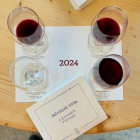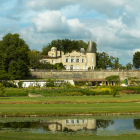There are many differences between Bordeaux’s Left and Right Bank wines. Geography is obviously the central factor, with the two areas divided between the River Garonne and the huge Gironde estuary. These waters have a significant influence on both the soil structure and climate of each region, giving each Bank its own unique characteristics. Wines of the Left Bank, dominated by Cabernet Sauvignon, typically have more tannin and a bigger structure than their Right Bank counterparts, which are predominantly Merlot-based, rich in fruit and softer in mouthfeel.
Then there’s estate size. The grand chateaux of the Left Bank – many over 100 hectares – are much larger than those on the Right Bank, which are often closer to an average of five hectares. And production volumes match: Chateau Lafite Rothschild, for example, will produce around 45,000 cases a year, while Pomerol’s Chateau Petrus makes around 2,000-3,500.
The Saint Emilion Classification
And then there’s classification. The famed 1855 Medoc Classification – which sorts chateaux in first, second, third, fourth and fifth growths – never included any Right Bank properties, and for some 100 years they went without any formal merit structure. Then in 1955, the Saint Emilion Classification system was created. (Pomerol – the Right Bank’s other shining star – is still without a formal classification system).
Unlike the Medoc Classification – which is largely set in stone – Saint Emilion revises and updates its classifications every 10 years or so. And rather than being judged on price, chateaux have to apply for inclusion and are judged by wine tastings spanning their previous 10 vintages.
The Classification groups wines into two categories: Premier Grand Cru Classe (which is then subdivided into tiers ‘A’ and ‘B’), and the less distinguished Grand Cru Classe. Unsurprisingly, this results in frequent confusion between the two categories, given the similarity of the terms, and that ‘Grand Cru’ is the sweeping term for (the hundreds of) wines produced in the Saint-Emilion appellation – many far from the quality of the Premier Grands Cru Classes. Additionally, the tiers ‘A’ and ‘B’ are often rarely used, given the rather unglamorous nature of their depiction.
Currently, there are four Premier Grand Cru Classe ‘A’ estates (Chateau Angelus, Chateau Ausone, Chateau Cheval Blanc and Chateau Pavie), 14 Premier Grand Cru Classe ‘B’ estates and 64 Grand Cru Classes.
Controversies
Given the critical importance of reputation in Bordeaux, it’s no surprise that classification years are often full of controversy. During the 2006 classification, for example, four producers – La Tour du Pin Figeac, Cadet Bon, Guadet and Chateau de la Marzelle – were dissatisfied by their demotion from Grand Cru Classe to Grand Cru and posed several confusing legal challenges that eventually invalidated the classification, resulting in reliance on the previous 1996 classification instead.
The next classification took place in 2012, and given the furore around the events of 1996, was conducted differently, with tastings and inspections outsourced by INAO (Institut National des Appellations d'Origine) to independent professionals from other wine regions in France. Predictably, not all parties were happy with these results either, with Corbin-Michotte, Croque-Michotte and Chateau La Tour du Pin Figeac (again) filing legal complaints. The next classification is due to take place in 2022, and will inevitably be accompanied by its own controversies.






